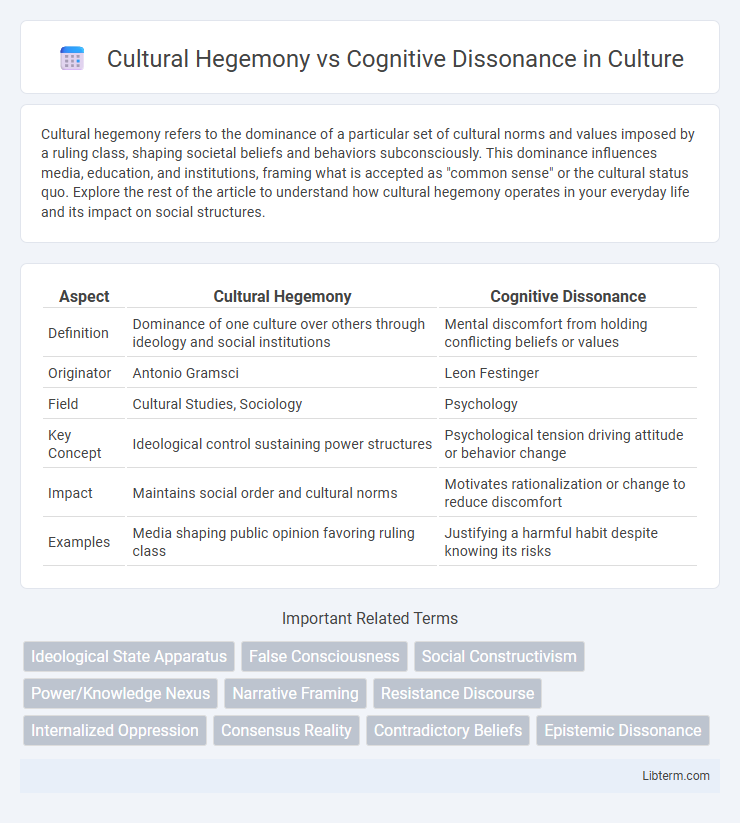Cultural hegemony refers to the dominance of a particular set of cultural norms and values imposed by a ruling class, shaping societal beliefs and behaviors subconsciously. This dominance influences media, education, and institutions, framing what is accepted as "common sense" or the cultural status quo. Explore the rest of the article to understand how cultural hegemony operates in your everyday life and its impact on social structures.
Table of Comparison
| Aspect | Cultural Hegemony | Cognitive Dissonance |
|---|---|---|
| Definition | Dominance of one culture over others through ideology and social institutions | Mental discomfort from holding conflicting beliefs or values |
| Originator | Antonio Gramsci | Leon Festinger |
| Field | Cultural Studies, Sociology | Psychology |
| Key Concept | Ideological control sustaining power structures | Psychological tension driving attitude or behavior change |
| Impact | Maintains social order and cultural norms | Motivates rationalization or change to reduce discomfort |
| Examples | Media shaping public opinion favoring ruling class | Justifying a harmful habit despite knowing its risks |
Introduction to Cultural Hegemony and Cognitive Dissonance
Cultural hegemony, a concept developed by Antonio Gramsci, explains how dominating groups maintain power by shaping societal norms, values, and beliefs to appear universal and natural. Cognitive dissonance, introduced by Leon Festinger, describes the mental discomfort individuals experience when holding conflicting attitudes or beliefs, often leading to rationalization or attitude change to restore psychological balance. Understanding cultural hegemony and cognitive dissonance is essential for analyzing power dynamics and behavioral responses within social structures.
Historical Roots of Cultural Hegemony
Cultural hegemony, a concept rooted in the works of Antonio Gramsci, emerged from the analysis of power dynamics within capitalist societies during the early 20th century. It explains how dominant groups maintain control by shaping cultural norms and ideologies, ensuring their values are accepted as common sense and natural. This historical framework highlights how societal consent is manufactured through institutions like media, education, and religion, contrasting with cognitive dissonance, which involves individual psychological discomfort when confronted with conflicting beliefs or behaviors.
Psychological Foundations of Cognitive Dissonance
Psychological foundations of cognitive dissonance originate from the human drive for internal consistency, where conflicting beliefs or behaviors cause mental discomfort, motivating individuals to reduce this dissonance through attitude or behavior change. Cognitive dissonance theory, developed by Leon Festinger, contrasts with cultural hegemony by emphasizing individual psychological processes over societal power structures influencing norms and beliefs. Understanding these foundations elucidates how internal conflict, rather than external cultural dominance alone, shapes belief adaptation and decision-making.
Mechanisms of Control: Culture vs. Mind
Cultural hegemony operates through dominant social norms and institutions, shaping collective beliefs and behaviors to maintain power structures within society. Cognitive dissonance functions internally, compelling individuals to resolve conflicting thoughts and emotions, thus enforcing conformity to personal or social expectations. While cultural hegemony uses external cultural narratives as mechanisms of control, cognitive dissonance relies on psychological discomfort to regulate individual mindset and behavior.
How Hegemony Shapes Perceptions
Cultural hegemony shapes perceptions by establishing dominant ideologies that influence societal norms, values, and beliefs, effectively molding individuals' worldview to align with ruling class interests. This process limits critical awareness by normalizing power structures and marginalizing alternative perspectives. The resulting consensus reduces cognitive dissonance by creating a perceived social reality that individuals internalize and rarely challenge.
Cognitive Dissonance in Societal Norms
Cognitive dissonance in societal norms occurs when individuals experience psychological discomfort due to conflicts between their personal beliefs and the dominant cultural expectations imposed by cultural hegemony. This mental tension often leads people to rationalize or modify their attitudes to align with prevailing social values, reinforcing the existing power structures. Understanding cognitive dissonance reveals how societal conformity is maintained despite internal contradictions, highlighting its role in perpetuating cultural dominance.
Intersections: When Hegemony Triggers Dissonance
Cultural hegemony enforces dominant ideologies that shape social norms, often conflicting with individual beliefs and experiences, thereby triggering cognitive dissonance. This psychological tension arises when people recognize disparities between imposed cultural narratives and their own values or realities, leading to internal conflict and potential social change. Understanding these intersections highlights how hegemonic control can provoke mental discomfort that motivates resistance or adaptation.
Real-World Examples and Case Studies
Cultural hegemony explains how dominant groups maintain power by shaping societal norms and beliefs, demonstrated by media conglomerates influencing public opinion in capitalist societies like the United States. Cognitive dissonance appears when individuals confront conflicting beliefs or actions, as seen in climate change denial despite scientific consensus, reflecting internal psychological tension. Case studies such as the civil rights movement reveal how challenging hegemonic narratives can reduce cognitive dissonance and promote social change.
Strategies for Resistance and Reconciliation
Strategies for resistance against cultural hegemony often involve fostering critical consciousness through education, promoting counter-narratives, and encouraging alternative cultural expressions that challenge dominant ideologies. Addressing cognitive dissonance requires cognitive restructuring techniques, including reframing beliefs and facilitating open dialogue to reconcile conflicting values and perceptions. Combining these approaches supports social movements and individual empowerment by enabling both systemic critique and psychological adaptation.
Conclusion: Implications for Social Change
Cultural hegemony perpetuates dominant ideologies by shaping societal norms and limiting alternative perspectives, which can hinder progressive social change. Cognitive dissonance arises when individuals encounter conflicting beliefs, prompting critical reflection or resistance to change depending on the social context and power dynamics. Understanding the interplay between these concepts reveals that challenging hegemonic narratives through cognitive dissonance is crucial for fostering transformative social movements and ideological shifts.
Cultural Hegemony Infographic

 libterm.com
libterm.com